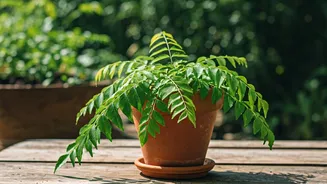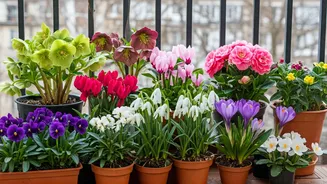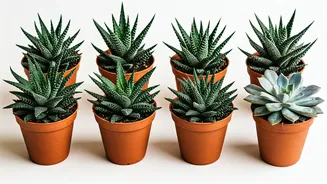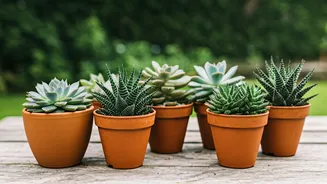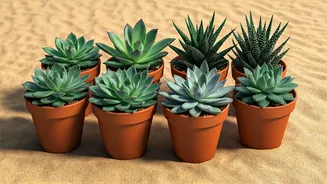Choose the Right Pot
Selecting the correct pot is crucial for the healthy growth of your curry leaf plant. Consider the material and size when choosing a pot for your curry leaves.
A pot with adequate drainage is essential, as curry leaf plants don't like to sit in water. A well-draining pot prevents root rot and ensures the plant thrives. The size of the pot should accommodate the plant's current size with room for future growth, allowing the roots to expand comfortably. Aim for a pot that’s at least 12 inches in diameter and depth. This gives the plant enough space to develop a strong root system, leading to a healthier and more productive curry leaf plant. Properly selecting the pot will improve your curry leaves harvest and keep your plant from dying.
Use Well-Draining Soil
Soil quality greatly influences the health of your curry leaf plant. Curry leaf plants thrive in soil that drains well. The soil should allow excess water to flow away rather than accumulating around the roots. To achieve good drainage, consider a mix that includes ingredients like perlite, sand, or coco coir. The mix provides air pockets and helps the water to drain properly, avoiding root rot. Ensure that the soil mix is rich in organic matter. You can incorporate compost or well-rotted manure to provide essential nutrients. This will promote strong growth and vibrant foliage. Moreover, the pH level of the soil should be slightly acidic to neutral (6.0-7.0) to facilitate the optimal absorption of nutrients. Using well-draining soil creates a favorable environment that allows curry leaves to grow and prosper.
Provide Plenty Of Sunlight
Sunlight is vital for the growth and vitality of your curry leaf plant. Curry leaf plants are sun-loving and require at least six hours of direct sunlight daily to flourish. Place your plant in a location where it can receive adequate sunlight. This is crucial for photosynthesis, the process by which plants convert sunlight into energy. If you are growing your plant indoors, a south-facing window is usually ideal. However, if such direct sunlight is not available, using grow lights can be a helpful alternative to ensure the plant gets enough light. During peak sunlight hours, protect your plant from excessive heat. This will help prevent the leaves from scorching. Providing ample sunlight not only promotes growth but also enhances the aroma and flavor of the curry leaves, making them more flavorful for your dishes.
Water Wisely
Proper watering is essential to the health and productivity of your curry leaf plant. The frequency of watering depends on various factors, including the climate, soil type, and pot size. Generally, water your curry leaf plant when the top inch of the soil feels dry to the touch. Avoid overwatering, which can lead to root rot. Instead, water deeply, ensuring that the water reaches the root system. Adjust the watering schedule depending on the season, as the plant needs more water during the growing season. In the winter months, reduce watering. Make sure the pot has good drainage to prevent waterlogging, and always let the excess water drain out of the pot. By following these guidelines, you can maintain healthy hydration, ensuring the plant thrives and provides you with flavorful leaves for your culinary adventures.
Mulch For Moisture Retention
Mulching your curry leaf plant helps maintain soil moisture. Mulch is a layer of organic material. Mulch helps reduce water evaporation, keeping the soil moist for longer. Mulch also helps regulate soil temperature, protecting the roots from extreme heat or cold. Common mulching materials include wood chips, shredded bark, and straw. Applying a 2-3 inch layer of mulch around the base of the plant is usually sufficient. Be sure to keep the mulch away from the plant stem to prevent rot. Mulching helps control weeds by blocking sunlight. This helps the plant focus its energy on growth rather than competing with weeds for nutrients and water. Regular mulching enhances the overall health and productivity of your curry leaf plant. Mulching is a simple yet effective technique for nurturing a thriving plant.
Prune Regularly
Pruning is important for the overall health and productivity of your curry leaf plant. Pruning promotes bushier growth and encourages the production of more leaves. Pruning should be done regularly, removing any dead, damaged, or diseased branches. To prune, use clean and sharp pruning shears. Cut the stems at an angle to encourage new growth. Pruning also helps improve air circulation. This can reduce the risk of pests and diseases. For a healthy plant, prune the curry leaf plant after harvesting leaves. Pruning the plant’s branches will help it stay healthy and provide you with fresh leaves for your kitchen garden. Regular pruning not only enhances the plant's appearance but also ensures a continuous supply of fresh, flavorful curry leaves.
Harvest Carefully
Harvesting your curry leaves correctly ensures the continued health and productivity of your plant. You can start harvesting leaves once the plant is established and has sufficient foliage. Harvest the leaves from the outside branches first, leaving the inner leaves to continue growing. Use your fingers or sharp scissors to pinch or cut the leaves or stems at the base, taking care not to damage the plant. Avoid taking too many leaves at once. This ensures that the plant retains enough foliage for photosynthesis and growth. For a more flavorful harvest, it's best to collect leaves in the morning, when their essential oils are most concentrated. Regularly harvesting leaves will encourage the plant to produce more leaves, providing you with a constant supply of fresh curry leaves. Taking care while harvesting will ensure the longevity and health of the plant.
